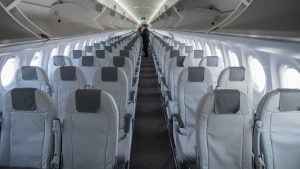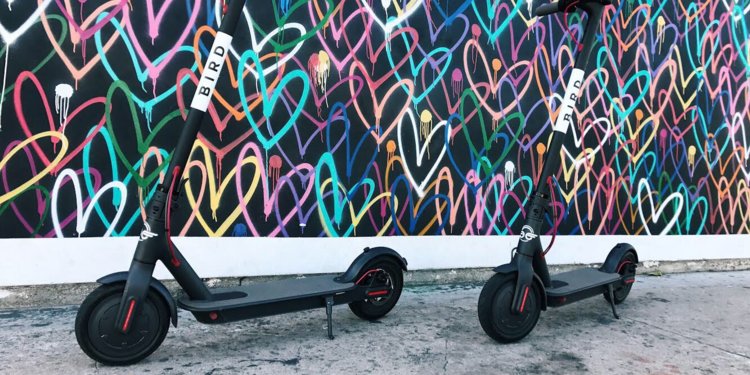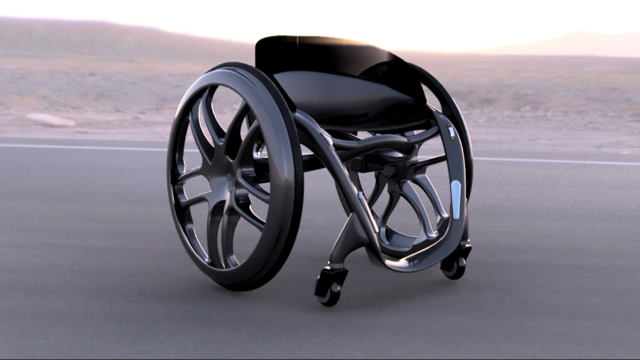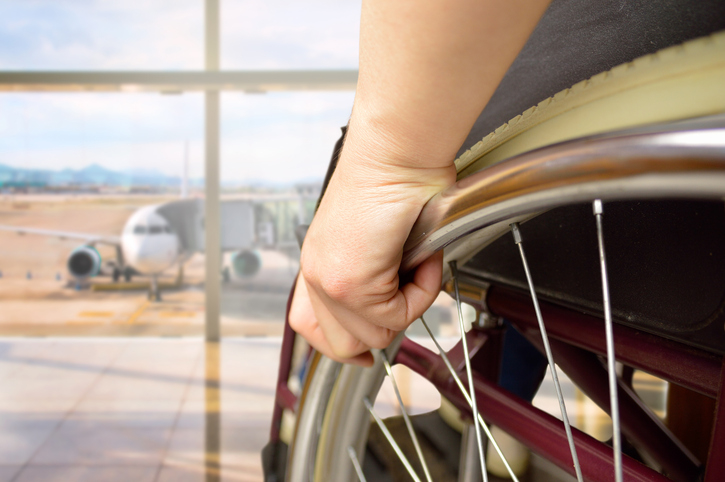For passengers who use wheelchairs, air travel in the United States can be an embarrassing, uncomfortable and perilous prospect. Read the full story here.
physical accessibility
Why Is Uber Charging Disabled People More?
As if there aren’t enough barriers for people using mobility devices or who have low vision to find appropriate transportation, those who can afford to use Uber’s ride-share service are being discriminated against. Read more here.
Amtrak Pays $2 Million to Passengers With Disabilities Who Faced Obstacles at Stations
Amtrak has paid more than $2 million to over 1,500 people with disabilities whom it discriminated against at nearly 80 train stations across the country. Read more here.
A new wheelchair will help this University of Florida student journalist do stand-ups — literally

By: Kelly Hinchcliffe, Poynter
Student journalist Drew Dees is kind but firm when he interviews people for his Florida college TV station.
Please stand up, he instructs them. Don’t crouch down in front of me. I’m not a baby.
He understands that people might not be used to seeing a journalist in a wheelchair — he never saw any on TV when he was growing up — but he demands to be treated the same as any other reporter.
“One of the big barriers in this career field is getting people to … take you seriously,” he said.
A 24-year-old junior at the University of Florida, Dees said he’s had overwhelming support from his family and professors as he pursues a degree in broadcast journalism. His dream of being an on-air reporter and anchor feels even more real now that his insurance company has agreed to provide him with a new $50,000 wheelchair. The Permobil F5 Corpus VS chair will allow him to move from a sitting position to standing with the touch of a button.
“It’s just going to make such a world of difference for me,” he said. “Just to be able to stand up and be able to talk to people on eye level and not have to look up at someone; that’s just the most amazing feeling to me.”
The chair will also allow him to do what’s known in TV news as a standup, where a reporter shares information on camera while standing or walking.
“It’s going to allow me to be more creative, to have more of that demonstrative standup that we look for instead of just being a talking head,” he said.
Dees got a test run of the new chair during a recent fitting to make sure it’s properly adjusted to his body. The chair won’t be ready for several months, but Dees was so excited that he posted a picture on social media of him using the chair to stand up. On a whim, he shared that photo and story in a journalism Facebook group that has about 15,000 members.
Read the full article here:https://www.poynter.org/reporting-editing/2019/a-new-wheelchair-will-help-this-university-of-florida-student-journalist-do-stand-ups-literally/
The Physics (and Economics, and Politics) of Wheelchairs on Planes
Flying can be stressful, painful, or simply impossible for wheelchair users. Critics say it doesn’t have to be that way.

WHEN SHANE BURCAW flies on an airplane, he brings along a customized gel cushion, a car seat, and about 10 pieces of memory foam. The whole arsenal costs around $1,000, but for Burcaw it’s a necessity.
The 27-year-old author and speaker — who, alongside his fiancée, Hannah Aylward, is one half of the YouTube duo Squirmy and Grubs — has spinal muscular atrophy, a genetic disorder that affects motor neurons and causes muscle wasting and weakness. The disorder contorted his limbs and he has used a wheelchair for mobility since he was 2 years old. Today, he uses a motorized wheelchair custom-fitted to his diminutive, 65-lb. frame, but to board an airplane, he’s required to give it up. Instead, Aylward must carry Burcaw onto the plane, and from there, transfer him into a child’s car seat, which provides limited support and does not fit his body (thus, the foam).
“When you hear about the injuries and the discomfort and the embarrassment that wheelchair users have faced when flying,” Burcaw said, “it becomes pretty obvious that they’re not being treated in a very humane way with these rules.”
Indeed, regulations prohibit passengers from sitting in their own wheelchairs on planes, and, as a result, 29 years after the passage of the Americans with Disabilities Act (ADA), which dramatically increased American wheelchair users’ access to buses, trains, and other essential 21st century infrastructure, airplanes remain stubbornly inaccessible. For many wheelchair users, the experience of flying is stressful, painful, and sometimes humiliating. For some, it is simply impossible.
Emily Ladau, a disability rights activist, writer, and public speaker, does deep-breathing exercises to manage her anxiety as airport staff take her wheelchair away. She likens the experience to watching someone walk off with her legs. Things aren’t much better onboard. “Airplane seats are designed for the quote-unquote average person,” Ladau said. “I’m nowhere near the quote-unquote average person.” At 4’6”, she does not fit the seat easily. Her legs dangle. She cannot align her posture. “It’s very uncomfortable,” she said.
Read the full article here: https://undark.org/2019/12/03/making-flying-safe-accessible/?fbclid=IwAR12anC3a_5uwrH1MBh9q4wRUi6txearETo1yedwgZBm4LGfTmO079kf9vA
Washington Post food critic to add accessibility to restaurant reviews

Tom Sietsema, a well-known food critic for the Washington Post, has announced that he will add accessibility information to his restaurant reviews. His decision, as Sietsema explains in a post published earlier this week, was prompted by feedback he’s received from readers, who frequently contact Sietsema to ask about restaurants’ accommodations for people who use wheelchairs, or people who are blind. Sietsema said he initially had concerns about remaining under-the-radar as a restaurant critic “while measuring doorways with a tape measure.” But, upon considering that more than 70,000 Washingtonians live with a disability, Sietsema realized the importance of his obligation to serve his audience.
Click here to read Sietsema’s announcement in the Washington Post.
City of San Diego and scooter companies sued by disability rights group

Disability Rights California (DCA), a non-profit disabilities rights group, has filed a class-action lawsuit against the city of San Diego and three dockless scooter companies. The lawsuit names San Diego and scooter companies Bird, Lime, and Razor as violating the Americans with Disabilities Act by obstructing the city’s sidewalks, crosswalks, transit stops, and curb ramps. Put more simply, the plaintiffs say the scooters render San Diego’s public walkways inaccessible for people with visual and mobility impairments.
You can read more about the lawsuit online, or download a PDF of this NBC 7 San Diego news article.
Toyota’s $4 million competition to re-invent the wheelchair

Toyota announced five finalists for its Mobility Unlimited Challenge at the 2019 Consumer Electronics Show (CES) in Las Vegas yesterday. Launched in 2017, the Mobility Unlimited Challenge is a contest that invites engineers, inventors, and designers from around the world to rethink the conventional wheelchair and develop a new way for people with lower-limb paralysis to get around. Each of the finalists will receive a grant of $500,000 to develop their concept further, with the final winner receiving $1 million in Tokyo in 2020.
Click here to read more about the competition online, or click here to download a PDF file of Toyota’s press release.
New law requires airlines to disclose how many wheelchairs they break
Beginning in January 2019, airline passengers can search the U.S. Department of Transportation website to determine an airlines’ track record of handling wheelchairs and other mobility devices. A new law sponsored by U.S. Sen. Tammy Duckworth, D-Ill., requires air carriers to be more transparent, obliging them to provide monthly reports that are publicly accessible and which detail the number of wheelchairs, checked bags, and motorized scooters lost, broke, or mishandled during flights.
The law was actually passed two years ago, but the Department of Transportation delayed its implementation until Duckworth–a veteran and wheelchair user herself–urged U.S. Secretary of Transportation Elaine Chao to force airlines to make the data — which they already collect each month — available to the public.
Click here to access the article on the Chicago Tribune’s website.
“Accessibility Is Not A Partisan Issue”
In an article for the Arizona Capitol Times, Katie Campbell details changes that are underway to make the Arizona State Capitol building more accessible for not just one new elected official, but all Arizonans. Jennifer Longdon, a presumptive state representative from Legislative District 24, uses a wheelchair and has drawn lawmakers’ attention to areas of the Capitol that are not easily accessible for people who use wheelchairs.
According to Longdon, Campbell writes, “this is just the first step toward making the Capitol more inclusive to everyone, both physically and in the policies that lawmakers craft.” Read the Arizona Capitol Times story here.



